Young gardeners will be surprised to learn how many mistakes can be made when planting a tree. How to plant a tree without making these annoying mistakes, most of which cannot be corrected. Let's look at the landing rules in detail.
When to plant trees
It is best to plant trees in early spring. Only in the south, where winters are warm, can seedlings be planted in the fall without risk. The reason is simple.When digging seedlings out of the ground, most of the small roots are broken off, and it is through them that the trees receive nutrition.
To create new branches after planting, it takes time (2 months) and heat, which is in short supply in the fall. Young trees do not have time to take root and die in winter.
Planting trees in early autumn is also not an option. Seedlings should be removed from the soil after the end of the growing season (after the leaves fall off). In the fall, you can safely plant plants that have a closed root system. You just need to remember that a closed root system is when the plant is grown in a pot, and not dug yesterday and stuck in a bucket of soil.
It is wiser to dig up seedlings purchased in the fall for the winter and plant them in the spring. This way they will be preserved better.
How to plant a tree correctly
The best seedlings may not yield a good harvest if they are not planted correctly. The most common mistake when planting a tree is excessive depth.
Almost everyone knows the basic rule of planting - deepen to the root collar. And where it is located is determined erroneously. Many people consider the grafting site to be the root collar, and the grafting occurs 15 centimeters above the roots and planting at such a depth dooms the tree to gradual death.
To plant a tree correctly, you need to clearly know that the root collar is the specific place where the trunk ends and the roots begin. You can't bury it!
Deepening inevitably leads to rotting of the bark. The decay process is slow; ring damage to the trunk is not noticed for a long time. Trees can grow and bear fruit, but gradually take on a depressed appearance. It seems that they are not getting enough food. Attempts to feed the plants intensively do not help.Nutrition does not flow from the roots to the crown due to circular damage to the bark at the root collar.
Before planting your tree, check the roots for growths. The growths are small and
quite large. This is a dangerous bacterial disease - root canker. If the growths are removed in a timely manner, the tree will develop normally in the future.
But sometimes they are located at the root collar, and it is impossible to cut them out there. You can’t leave it either - the seedling will gradually die and contaminate the soil, so there’s no point in planting it.
Injured, soaked ends of the roots are cut to a healthy place.
Planting pits.
On well-cultivated soils or black soils, you can do without special planting holes, making only depressions according to the size of the roots. On poor lands, large planting holes are prepared and, before planting a tree, they are filled with fertile soil with the addition of fertilizers.
This is done to ensure favorable conditions for the growth and development of plants in the first years. The larger the hole, the longer the favorable period will be. Subsequently, the roots will extend beyond its boundaries, so do not expect that the contents of the hole will provide the seedling with food for life.
The main mistakes when planting trees are shown in the figures:
- Error: the seedling is deeply buried. (the worst mistake is Figure 1) And it is already useless to start digging out the root collar, creating a depression. Moisture will accumulate in such a funnel and cause rotting and death of the bark.
- Error: deepening the entire hole, that is, the ground level in the hole is below the level of the edges of the planting hole. This is the result of planting in a freshly dug hole. The soil settled along with the seedling. Therefore, it is necessary to prepare and fill the planting holes in advance so that the soil has time to settle.
- Error: after planting the tree, a void remained under the root collar (white spot in Figure 1). Without contact with the soil, the roots in this area will become moldy and gradually die. Voids will not form when planted on an earthen mound (Figure 2). If there are a lot of roots, distribute them evenly along the walls of the mound, making sure that they do not bunch up in one heap. During the planting process, water the seedling, add soil and water again, shake it and pull it up.
- Error: sloping walls near the planting pit (Figure 1). The shape of the pit can be any (round, square), but always make the walls vertical (Figure 2). The subsidence of the earth in the cone-shaped hole is not uniform, which contributes to the deepening of the trunk.
- Error: The roots of the seedling rest against the walls of the pit (Figure 1). This will complicate the formation of callus on the roots, and therefore the survival of the tree. Do not level the walls of the planting hole with a shovel. On the contrary, loosen the bottom and walls as much as possible.
- Error: the peg is driven too shallow. The stake should be driven deeper into the ground (Figure 2) so that the plant does not sway in the wind.
- Error: The tree is tied tightly to a peg. Be sure to make the garter in a figure eight (Figure 2) - this way it can absorb the impact of the wind. Choose a peg that is not high, so that in the wind the crown of the tree will not be injured by it.
At what distance are trees planted?
When planting, the following distances should be maintained between trees:
- between apple trees and pears 5 - 6 m.
- columnar apple trees 2 - 2.5 m.
- plums, cherries 3 m.
- felt cherry 1.5 m.
- shrubs 1 - 1.5 m.
- ornamental plants 2 - 3 m.
- ornamental plants with a narrow crown (arborvitae, yew) 1 m.
- in a single-row hedge 0.3 m.
- in a multi-row hedge 0.5 m.
Distance between trees and buildings on the site:
- 5 m from the house and other buildings.
- from the edge of the path 1.5 m.
- from the power supply pole 4 m.
- from underground communications 1.5 - 2 m.
Distance from trees to neighbors' property:
- tall trees 4 m.
- medium-sized trees 2 m.
- various shrubs 1 m.
Planting fruit trees on hills
Planting fruit trees on hills and ramparts is recommended in low areas where groundwater lies close to the soil horizon. In stagnant groundwater, natural air exchange is disrupted and carbon dioxide, which is harmful to the root system, accumulates.
The roots gradually rot, signaling this by dry tops, that is, drying of the branches at the tops of the plants. No amount of iron sheets or slate placed under the roots when planting trees will help, since they do not prevent the penetration of moisture. During the growth process, the roots of seedlings bypass obstacles, become buried and rot.
In low, waterlogged areas, it is necessary to organize soil drainage, constantly increase the soil level and plant fruit trees on shafts and high ridges.
It is not necessary to import land of dubious quality with machines; you can do everything yourself. At first, such work may seem very labor-intensive, but it can be done in the fall in one week, and in the spring you can start planting the garden.
A trench is dug at the site where trees are supposed to be planted. Place the top fertile and bottom infertile layers of soil on opposite sides of the ditch.The trench is filled with unnecessary logs, old boards, branches, and grass. All this is covered first with infertile soil, and on top with dark, good soil.
This way the ground level rises, and the soil under the trees is saturated with humus. Hills are prepared in a similar way. Every summer they throw grass and leaves on them and thus expand them. The diameter of the hills is made at least two meters. But even when trees are planted on hills, the root collar should not be below soil level.
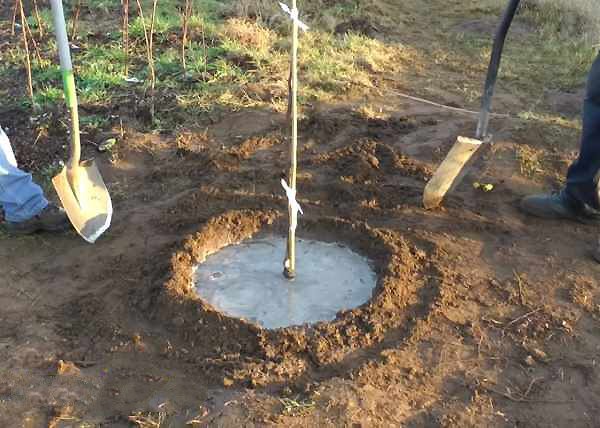
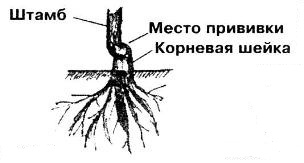
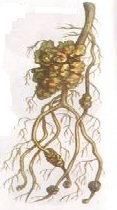
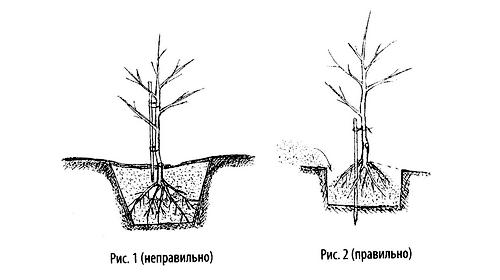
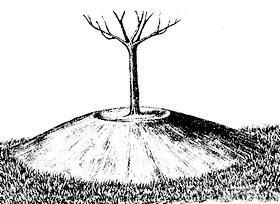
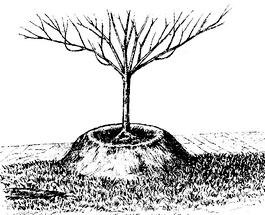

 CUCUMBERS NEVER GET SICK, I'VE BEEN USING ONLY THIS FOR 40 YEARS! I SHARE A SECRET WITH YOU, CUCUMBERS ARE LIKE THE PICTURE!
CUCUMBERS NEVER GET SICK, I'VE BEEN USING ONLY THIS FOR 40 YEARS! I SHARE A SECRET WITH YOU, CUCUMBERS ARE LIKE THE PICTURE! You can dig a bucket of potatoes from each bush. Do you think these are fairy tales? Watch the video
You can dig a bucket of potatoes from each bush. Do you think these are fairy tales? Watch the video
 How our fellow gardeners work in Korea. There is a lot to learn and just fun to watch.
How our fellow gardeners work in Korea. There is a lot to learn and just fun to watch. Eye trainer. The author claims that with daily viewing, vision is restored. They don't charge money for views.
Eye trainer. The author claims that with daily viewing, vision is restored. They don't charge money for views. A 3-ingredient cake recipe in 30 minutes is better than Napoleon. Simple and very tasty.
A 3-ingredient cake recipe in 30 minutes is better than Napoleon. Simple and very tasty. Therapeutic exercises for cervical osteochondrosis. A complete set of exercises.
Therapeutic exercises for cervical osteochondrosis. A complete set of exercises. Which indoor plants match your zodiac sign?
Which indoor plants match your zodiac sign? What about them? Excursion to German dachas.
What about them? Excursion to German dachas.
How many trees have I replanted in my life and didn’t know it was so difficult! Well, be simpler
I'm glad this article exists. How many mistakes in tree planting have been professionally pointed out that I did not know about as a “young naturalist”! It’s a pity that I didn’t come across this article earlier, 3 years ago, when I was planting an orchard. And now some of my trees have died and dried out after a year or two, and they still couldn’t withstand the drought of last summer. Thanks for the advice!
Good luck to you, Evgeniya and thank you for your kind words.
Thanks for the advice! They were very useful when milking newbies like us) planting fruit trees for the first time)
I’m very glad, Angela, that the article was useful to you.